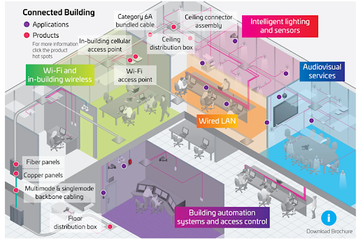But first, let’s discuss the importance of versatility. WD-40, owned, branded, and manufactured by the WD-40 manufacturing company in San Diego, California, is one of the most versatile products on the market today. But it wasn’t supposed to be. It was developed to solve one objective, nothing more. It was originally developed as a rust-prevention solvent and degreaser for the aerospace industry.
Today there are hundreds of known uses for WD-40 and people are coming up with new ones all the time. Squeaky door hinge? WD-40. Stains in the toilet bowl? WD-40. Run out of ketchup? WD-40. Just kidding,don’t use WD-40 in place of ketchup.
If WD-40 is known for anything, it’s known for being versatile. There is likely a can of WD-40 in just about every American household, and it is regularly used beyond its original intent.
Cat6A is arguably the most versatile twisted pair cable available, and it too continues to find new uses beyond its original intent.
You see, Cat6A was developed to solve one objective: 10 Gigabit out to 100 meters. In order to do this, we needed to develop better alien crosstalk mitigation as the bandwidth of the application shifted from 250 megahertz to 500 megahertz.
Alien Crosstalk mitigation. Without it, there’s no Cat6A. But with it, we have the ability to deploy all of these applications seen here, with confidence that these different systems will operate consistently as intended.
This is especially true as connectivity moves from the walls to the ceiling. When you think of the variety and complexity of these different applications – such as Wi-Fi 6, in-building wireless, and a multitude of PoE devices – it becomes easy to see why you need the most robust infrastructure available.
These days, it seems like everything is running over twisted pair. Proprietary infrastructure has converged – four-pair cabling now supports the majority of building applications, leading to smart buildings and a whole new way to manage these applications.
Of course, not all applications need Cat6A – or 10 Gigabit bandwidth – but many need at least multi-gigabit. And although there is a new solution for this that we’ll discuss in a moment, you don’t always know from the beginning which applications you will need on each run of cable.
I’ve heard many times from people either trying to save money or just being a cynical contrarian trying to make the claim that just about everything can run on plain old Cat6 and very few applications require speeds above one gigabit.
Here’s the thing, I drive a fairly large truck as my daily driver, and I’ve been questioned about the need for driving such a large vehicle when I could get away with using a much smaller vehicle. But I prefer the versatility my truck affords me. I may never need the full capacity and power my truck has available, but I often need more power and capacity than an average SUV or small truck provides.
I’ve also had people look at my truck and tell me they can tow a trailer just fine with their car. Maybe. Maybe not. But even if they could, I assure you they would prefer the power and confidence you get using a truck better designed for such a job.
You don’t want to wonder if your truck can handle the job long after you’ve committed to the job. It’s better to make sure you have a versatile and capable tool for any job you may be faced with. Cat6A gives you the capability and versatility like the power and capacity of a large and powerful truck.
Probably the most important aspect of all of this is this simple fact – we have no idea what new applications we’ll be running over our networks over the coming decades. Twenty years ago, we needed Cat6A to do one thing.
Today, there’s a myriad of applications running over twisted pair, many of which require capabilities better suited for Cat6A. With the recent explosion of AI and the ongoing evolution of the smart building, those who still promote Cat6 are quickly at risk of suffering from the Dunning-Kruger effect.
When you look at the various standards ratified over the past few years you begin to see a common thread where Cat6A is either recommended or required. It’s only a matter of time before we see this across the board for all applications and spaces relying on twisted pair for their infrastructure.
From applications like Wi-Fi 6 and PoE++ to spaces such as data centers, health care, and education, the strong recommendation for Cat6A continues to grow and evolve. Let’s look at a few of the applications driving the demand for versatility and capabilities that Cat6A is best suited for.
Wi-Fi 6/6E
While Cat 5e and Cat 6 cabling could support early Wi-Fi 6 deployments with 2.5GBASE-T or 5GBASE-T, this is not expected to be the case in the future. Today’s 802.11ax (aka Wi-Fi 6) access points allow a maximum speed of 6.77 Gbps, requiring a 10GBASE-T connection to support the highest possible data rate. TSB-162-A, Telecommunications Cabling Guidelines for Wireless Access Points, also recommends running at least Category 6A or higher cabling to all wireless access points.
High-performance computing (HPC) and Edge compute
Many industry sectors now utilize high-performance computing platforms to support highly bandwidth-intensive applications such as streaming video, medical imaging, centralized applications, high-end graphics, visualization technologies, and data clustering. In addition, Edge compute continues to grow as advanced applications demand it. Cat 6A’s expanded data capacity will be key to enabling these capabilities.
Storage area networks (SAN) and network attached storage (NAS)
10 Gigabit Ethernet enables cost-effective, high-speed infrastructure for both network-attached storage (NAS) and storage area networks (SAN). 10 Gigabit Ethernet can offer equivalent or superior data-carrying capacity at latencies similar to many other storage networking technologies, including fiber channel, ATM OC-3, OC-12 and OC-192, and InfiniBand.
Multi-site collaboration
Collaboration tools are emerging that enable conference participants to write or draw on a blank slide, connect to a web site, and engage in private communication with the conferencing host or any other participants. These collaborative tools will increasingly require more bandwidth, and 10 Gigabit Ethernet connections will be the primary link for enabling multi-site collaboration within an enterprise.
Grid computing
Grid computing makes “spare” desktop CPU horsepower available across the network to large jobs that require it. Grid computing effectively provides the horsepower “across the network” to support such applications. This demands high-speed connections among participating compute platforms, making Cat 6A the logical Ethernet choice.
Now, we mentioned earlier the growing need for multi-gigabit performance and not necessarily needing Cat6A for these. We do realize not every IT professional sees the need to deploy Cat6A from day one.
There are still many situations that don’t require the versatility and performance of Cat6A throughout the entire network but require at the very least multi-gigabit in specific areas of the network for specific applications, but without the hassle of mitigation efforts.
The GigaSPEED XL5 solution, a new addition to the GigaSPEED family, addresses the growing sweet spot for a Category 6 solution that can support the intermediate 2.5 and 5.0 GBE bandwidth demands, guaranteed and without mitigation.
GigaSPEED XL5 cables can support four connections in a 100 meters channel to support 5G Ethernet. So, it’s ideal for connecting wireless access points located in the ceiling. And because the cable diameter is only slightly larger than GigaSPEED XL cables, the installation tools and procedures are the same as well.
Some companies are now beginning the transition from Wi-Fi 6 to more bandwidth heavy Wi-Fi 6E. It will be several more years before the migration to Wi-Fi 7 and its 10+ GbE demands. As a result, the GigaSPEED XL5 solution has an important role to play in enterprise networks for many years to come.
The need for multi-gig speeds will continue to grow with GigaSPEED XL5 cables quickly becoming the logical minimum. And this is all pointing to eventually needing Cat6A everywhere. For temporary installations of five years or less, perhaps the GigaSPEED XL5 solution solves all network needs. For a permanent network expected to last twenty or more years, Cat6A such as SYSTIMAX GigaSPEED X10D is absolutely the correct choice.
Looking towards a more resilient, future-ready enterprise network
Looking back on the versatility and performance of Cat 6A cabling, we see that it has enabled the development and deployment of many bandwidth-hungry applications that today’s enterprises cannot do without.
And it is not finished yet – it remains the recommended infrastructure for modern new-builds and promises to remain relevant for many years to come. Proof of its success can be seen in the sales volume that continues to grow, almost two decades after the initial draft of the standard.
While you may never be able to completely future-proof your enterprise network, you can ensure it is future-ready.
To learn more about how CommScope’s SYSTIMAX, Uniprise and NETCONNECT Cat 6A portfolios can help you build a more resilient and adaptable network, check out the Category 6A resource page.
More from Commscope
-

DCD>Talks generative AI and impact on data center fiber optic network design with Kamlesh Patel, CommScope
DCD's Stephen Worn chats with Kamlesh Patel from CommScope about generative AI and the impact on data center fiber optic network design
-

Sponsored Propelling the industry forward
A Q&A with CommScope's Ken Hall
-

Sponsored Data centers and Industry 4.0: The next manufacturing revolution
The data centers’ role in the next evolution of industry



